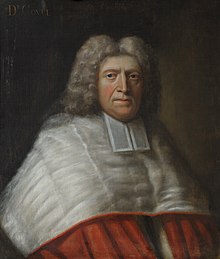Wikipedia
This text was copied from Wikipedia on 20 July 2024 at 5:10AM.

John Covel (2 April 1638 – 19 December 1722) was a clergyman and scientist who became Master of Christ's College, Cambridge and vice-chancellor of the University.[1]
Diplomacy
Born at Horningsheath, Suffolk, the son of William Covel, John Covel was educated at Bury St Edmunds school and Christ's College, Cambridge, where he was made a fellow in 1659.[2] In 1670 he went to Constantinople as Chaplain to the Levant Company. For two years he was in sole charge of the English Embassy there after the previous ambassador died.[3]
Travel and scholarship
Covel travelled widely in Asia Minor and described the buildings and plants which he saw. He purchased many Greek manuscripts (including codices 65, 110, 321, 322, and ℓ 150).
After his return, Covel spent the winter of 1680/1681 in Suffolk suffering with fever,[4] before becoming Chaplain to the Princess of Orange in The Hague (1681–1685). He was then elected the 15th Master of Christ's in 1688, a position he held until 1723.[5]
In his later years, Covel helped to develop the study of fossils.[6]
References
- ^ Elisabeth Leedham-Green, 'Covel , John (1638–1722)', Oxford Dictionary of National Biography, Oxford University Press, 2004, accessed 23 December 2007.
- ^ "Covel or Covill, John (CVL654J)". A Cambridge Alumni Database. University of Cambridge.
- ^ "Electronic Enlightenment: John Covel". www.e-enlightenment.com. Retrieved 31 December 2020. Electronic Enlightenment: John Covel.
- ^ "Electronic Enlightenment: John Covel to John Locke". www.e-enlightenment.com. 2019. doi:10.13051/ee:doc/lockjoou0020350b1c. Retrieved 31 December 2020.
- ^ "Christ's College website – list of previous masters". Archived from the original on 11 February 2012. Retrieved 25 June 2008.
- ^ Christ's College Magazine, No 154, Easter term 1942.
Further reading
- Jean-Pierre Grélois, ed., Dr John Covel, Voyages en Turquie 1675–1677. Texte établi, annoté et traduit par Jean-Piere Grélois, avec une préface de Cyril Mango (Réalités Byzantines 6). Paris, 1998. ISBN 978-2-283-60456-4
- Covel, John (1893). "Extracts from the diaries of John Covel (1870-1879)". In Bent, J. Theodore (ed.). Early voyages and travels in the Levant. London: Hakluyt Society. pp. 99–287.
- "John Covel". Electronic Enlightenment Biographical Dictionary. 2019. doi:10.13051/ee:bio/coveljohn0004729.
0 Annotations